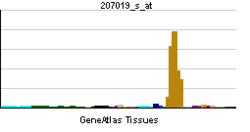AKAP4
| View/Edit Human | View/Edit Mouse |
A-kinase anchor protein 4 is a scaffold protein that in humans is encoded by the AKAP4 gene.[3][4][5]
Function
The A-kinase anchor proteins (AKAPs) are a group of structurally diverse proteins, which have the common function of binding to the regulatory subunit of protein kinase A (PKA) and confining the holoenzyme to discrete locations within the cell. This gene encodes a member of the AKAP family. The encoded protein is localized to the sperm flagellum and may be involved in the regulation of sperm motility. Alternative splicing of this gene results in two transcript variants encoding different isoforms.[5]
Clinical significance
AKAP4 is a potential biomarker for early diagnosis and immunotherapy of colon cancer.[6] AKAP4 may be implicated as a biomarker and immunotherapeutic target for cervical cancer.[7] AKAP4 is also a circulating biomarker for non-small cell lung cancer.[8]
Interactions
AKAP4 has been shown to interact with:
References
- ↑ "Human PubMed Reference:".
- ↑ "Mouse PubMed Reference:".
- ↑ Turner RM, Johnson LR, Haig-Ladewig L, Gerton GL, Moss SB (November 1998). "An X-linked gene encodes a major human sperm fibrous sheath protein, hAKAP82. Genomic organization, protein kinase A-RII binding, and distribution of the precursor in the sperm tail". The Journal of Biological Chemistry. 273 (48): 32135–41. doi:10.1074/jbc.273.48.32135. PMID 9822690.
- ↑ Mohapatra B, Verma S, Shankar S, Suri A (March 1998). "Molecular cloning of human testis mRNA specifically expressed in haploid germ cells, having structural homology with the A-kinase anchoring proteins". Biochemical and Biophysical Research Communications. 244 (2): 540–5. doi:10.1006/bbrc.1998.8079. PMID 9514854.
- 1 2 "Entrez Gene: AKAP4 A kinase (PRKA) anchor protein 4".
- ↑ Jagadish N, Parashar D, Gupta N, Agarwal S, Sharma A, Fatima R, Suri V, Kumar R, Gupta A, Lohiya NK, Suri A (February 2016). "A novel cancer testis antigen target A-kinase anchor protein (AKAP4) for the early diagnosis and immunotherapy of colon cancer". Oncoimmunology. 5 (2): e1078965. doi:10.1080/2162402X.2015.1078965. PMC 4801464
 . PMID 27057472.
. PMID 27057472. - ↑ Agarwal, Sumit; Saini, Shikha; Parashar, Deepak; Verma, Archana; Jagadish, Nirmala; Batra, Aruna; Suri, Sushma; Bhatnagar, Amar; Gupta, Anju (2013-05-01). "Expression and humoral response of A-kinase anchor protein 4 in cervical cancer". International Journal of Gynecological Cancer: Official Journal of the International Gynecological Cancer Society. 23 (4): 650–658. doi:10.1097/IGC.0b013e31828a0698. ISSN 1525-1438. PMID 23478221.
- ↑ Gumireddy K, Li A, Chang DH, Liu Q, Kossenkov AV, Yan J, Korst RJ, Nam BT, Xu H, Zhang L, Ganepola GA, Showe LC, Huang Q (July 2015). "AKAP4 is a circulating biomarker for non-small cell lung cancer". Oncotarget. 6 (19): 17637–47. doi:10.18632/oncotarget.3946. PMC 4627334
 . PMID 26160834.
. PMID 26160834. - 1 2 Brown PR, Miki K, Harper DB, Eddy EM (June 2003). "A-kinase anchoring protein 4 binding proteins in the fibrous sheath of the sperm flagellum". Biology of Reproduction. 68 (6): 2241–8. doi:10.1095/biolreprod.102.013466. PMID 12606363.
- ↑ Miki K, Eddy EM (December 1998). "Identification of tethering domains for protein kinase A type Ialpha regulatory subunits on sperm fibrous sheath protein FSC1". The Journal of Biological Chemistry. 273 (51): 34384–90. doi:10.1074/jbc.273.51.34384. PMID 9852104.
External links
- Human AKAP4 genome location and AKAP4 gene details page in the UCSC Genome Browser.
Further reading
- Lester LB, Scott JD (1997). "Anchoring and scaffold proteins for kinases and phosphatases". Recent Progress in Hormone Research. 52: 409–29; discussion 429–30. PMID 9238861.
- Michel JJ, Scott JD (2002). "AKAP mediated signal transduction". Annual Review of Pharmacology and Toxicology. 42: 235–57. doi:10.1146/annurev.pharmtox.42.083101.135801. PMID 11807172.
- Miki K, Eddy EM (December 1998). "Identification of tethering domains for protein kinase A type Ialpha regulatory subunits on sperm fibrous sheath protein FSC1". The Journal of Biological Chemistry. 273 (51): 34384–90. doi:10.1074/jbc.273.51.34384. PMID 9852104.
- Turner RM, Foster JA, Gerton GL, Moss SB, Patrizio P (August 2001). "Molecular evaluation of two major human sperm fibrous sheath proteins, pro-hAKAP82 and hAKAP82, in stump tail sperm". Fertility and Sterility. 76 (2): 267–74. doi:10.1016/S0015-0282(01)01922-7. PMID 11476771.
- Ficarro S, Chertihin O, Westbrook VA, White F, Jayes F, Kalab P, Marto JA, Shabanowitz J, Herr JC, Hunt DF, Visconti PE (March 2003). "Phosphoproteome analysis of capacitated human sperm. Evidence of tyrosine phosphorylation of a kinase-anchoring protein 3 and valosin-containing protein/p97 during capacitation". The Journal of Biological Chemistry. 278 (13): 11579–89. doi:10.1074/jbc.M202325200. PMID 12509440.
- Brown PR, Miki K, Harper DB, Eddy EM (June 2003). "A-kinase anchoring protein 4 binding proteins in the fibrous sheath of the sperm flagellum". Biology of Reproduction. 68 (6): 2241–8. doi:10.1095/biolreprod.102.013466. PMID 12606363.
- Lefièvre L, Chen Y, Conner SJ, Scott JL, Publicover SJ, Ford WC, Barratt CL (September 2007). "Human spermatozoa contain multiple targets for protein S-nitrosylation: an alternative mechanism of the modulation of sperm function by nitric oxide?". Proteomics. 7 (17): 3066–84. doi:10.1002/pmic.200700254. PMC 2777308
 . PMID 17683036.
. PMID 17683036. - Moretti E, Scapigliati G, Pascarelli NA, Baccetti B, Collodel G (September 2007). "Localization of AKAP4 and tubulin proteins in sperm with reduced motility". Asian Journal of Andrology. 9 (5): 641–9. doi:10.1111/J.1745-7262.2007.00267.X. PMID 17712481.
